Beef Doenjang Jjigae (Korean Soybean paste stew) made with restaurant Kalbi leftovers is my favorite way to make the most hearty, spicy and earthy stew. The marinated Kalbi bones make an amazingly rich broth and the addition of gochujang in this recipe gives the dish a fabulous spicy kick! A must try if you frequent Korean BBQ restaurants and come home with leftover Kalbi.

Doenjang Jjigae or Korean soybean paste stew has many variations, just like you can make a tomato-based pasta sauce so many different ways. You can make this jjigae with just anchovy stock, with beef, with pork, with seafood or just vegetables. Doenjang works great with any proteins and many different vegetables (as long as it doesn’t have too strong a flavor) that the combinations are pretty endless.
Back in 2016, I shared the most classic version using an Anchovy Broth + rice water as the soup base then adding soybean paste and some veggies. Today, I want to share a different way of making it, using leftover Kalbi ribs that you can get at a Korean BBQ restaurant or after a BBQ at home. Cooking the marinated Kalbi rib bones and meat takes a bit of extra time, but the broth you get from this is so amazingly delicious that I decided to share it as a separate post.
Also, in this version, I add a bit of gochujang which makes it spicier and funkier, tasting totally different from the pure Doenjang only jjigae. The gochujang works great in this recipe because it works to break up the rich, heavy and slightly fatty Kalbi broth.
How do you make Doenjang Jjigae?
Here is a master recipe and tips for making your own version –
- Decide on the broth and protein – choose one or combination from Anchovy stock, Beef stock (saute beef first then water or use Kalbi stock like here), Rice Water, Seafood stock (one or more of clams, shrimp, squid, crabs all work great, add these to cold water then simmer until you get a flavorful stock), vegan kelp stock.
- Choose pastes – Doenjang only? or Doenjang + Gochujang? Choose how you want to go. Doenjang only will produce a more pure flavor of the soybean paste while adding gochujang will make it more complex with a spicy kick.
- Choose vegetables:
- Classic ones – zucchini, potatoes, mushrooms (see note below). Add radish if using beef broth.
- Seasonal ones – shepherd’s purse (naengyi 냉이), wild chives (dalae 달래) are 2 great Spring vegetables that are very aromatic and wonderful.
- Add tofu, green onions and red or green chilis (optional)
Onions – many like to add onions to Doenjang jjigae. I personally think it fights the flavor of Doenjang but up to you. Try it without it and taste the difference.
EXTRA FLAVOR addons – sprinkle red chili powder on top at the end, also use dried shrimp or dried anchovy powder for extra flavor
Follow this Order – to maximize flavor and texture variance, follow this order when making your Doenjang Jjigae
Make broth -> add Doenjang/Gochujang paste -> add root vegetables and zucchini, tofu -> add mushrooms or greens -> finish with green onions and chili. If using rehydrated shitake mushrooms, you can add it earlier with root veggies. For fresh mushrooms, add it to the end because they cook quickly.
Mushrooms – don’t use strong flavor mushrooms and not too much, you don’t want the mushrooms to overpower the Doenjang. Use fresh shitake or other fresh mild mushrooms like enoki, oyster. Personally, I don’t like button white or brown mushrooms because they are too strong in flavor.
Step-by-Step Instructions
How to make Kalbi Beef Broth for Beef Doenjang Jjigae on the Stove and Instant Pot
Btw, if you don’t have Kalbi, you can just use regular Beef Stew meat, Chadolbaegi (fatty thin brisket) or even ground beef.
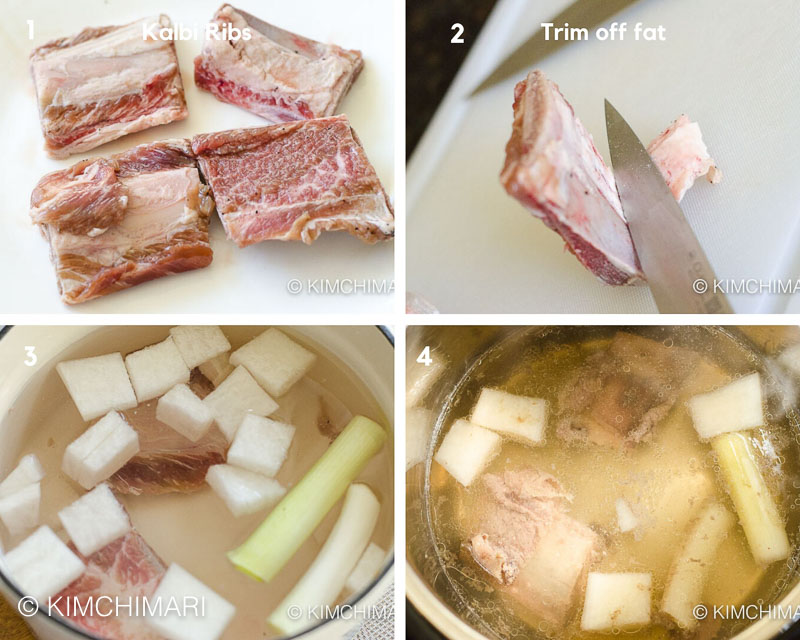
- Make beef broth – see pics above –
- these are leftover Kalbi ribs from our latest visit to a Korean BBQ restaurant. Instead of grilling them, I brought them home uncooked.
- Trim off fat as much as possible
- On the stove — in a pot, add Kalbi bones, water, cut radishes and green onion (Daepa/Korean leek is even better) – bring to boil then simmer for 40 minutes.
- In the Instant Pot — add Kalbi bones, water, radishes, green onions and set STEW/SOUP function for 25 (30 for most tender) minutes and Quick Release to save time or Natural Release if you have time.
- This is how the broth looks after it is done. Remove onion, green onions and discard. Take the meat and bones out – the meats should have fallen off the bone.
- Cut kalbi meat into thin strips so they are easier to eat. Add the meat back to the broth. You can discard the bones now or leave it in a little longer to get more flavor into the stew.
Cutting cooked Kalbi meat for jjigae - Prepare vegetables. Rehydrate shitake mushrooms in warm water until soft (20 min) and cut into squares. Cut zucchini, tofu, green chili peppers and green onions. Here, I used Jalapeno peppers but if you have Korean Putgochu 풋고추, that’s better.
Vegetable Ingredients on cutting board - Start cooking – In a clay pot (if you don’t have it – use regular pot), add Doenjang and Gochujang into the beef broth with cut meats. Smoosh the paste against the side of the pot with a spoon and rub it so it mixes into the broth easily and quickly. Watch video to see how it’s done.
boiling doenjang jjigae with vegetables added - Turn heat on to medium-high and bring it to boil. Then lower to medium heat – it should still be bubbling.
- Add zucchini and tofu and cook for 5-7 minutes until zucchini are soft and become semi-translucent.
- Add mushrooms, green onions and chili. Boil for another 2-3 minutes.
- Serve hot in the clay pot or in individual bowls, with some rice, meats (goes great with BBQ), side dishes. Enjoy!!
Doenjang Jjigae Beef closeup
Storage
Store leftover stew in the fridge. Add a little bit of water before reheating on the stove to make sure it’s not too salty.
Do you want to know more about Doenjang?
To understand more about Doenajng, the differences between different types, what is the best one to buy, how to store, etc – please read my Know your Doenjang post.
Doenjang (Korean Fermented Soybean Paste) is known to have many beneficial health effects. I talk more about it in the Know your Doenjang post above but also I found an interesting paper recently – here’s the title and link
And here’s a final close-up shot of my wonderful spicy Beef Soybean Paste Stew made with rich Kalbi broth using leftovers from a restaurant!

If you like Gochujang, you may enjoy this wonderful Gochujang Hobak Jjigae recipe made with Anchovy and Shitake broth! And here’s my Kalbi marinade recipe if you feel like making it at home instead of going to a restaurant – just use many bones since this will have thin LA style cut ribs.
Enjoy ❤️,
JinJOO
☆ Did you make this recipe? I hope you can give me a 5 star rating below!
You can also FOLLOW ME on YouTube, FACEBOOK, PINTEREST and INSTAGRAM or join my FACEBOOK GROUP to see, ask and share everything about Korean food with others just like you!
Beef Doenjang Jjigae with Kalbi (ribs)
Ingredients
Kalbi Beef Broth (Stove top and Instant Pot)
- 2 - 3 kalbi bones with meat
- 5 oz radish (sliced into 1/4 inch thin squares (5 oz = about 1 cup))
- 1 green onion or Daepa (Korean leek)
- 4.5 cups water (for stove top) (use 3.5 cups / 840 ml for Instant Pot)
Vegetables
- 1 zucchini (cut into 1/2 inch thick squares (1 zucchini = 1.5 cup))
- 7 oz extra firm tofu (cut into 1/2 inch thick slices)
- 1 green onion
- 2 dried shitake mushrooms (rehydrated or use fresh)
- 1 green chili pepper (Jalapeno is ok)
Seasoning
- 1 Tbsp Doenjang (soybean paste)
- 1/2 Tbsp Gochujang
- 1 tsp garlic (chopped)
Instructions
Make beef broth - see pics above -
- these are leftover Kalbi ribs from our latest visit to a Korean BBQ restaurant. Instead of grilling them, I brought them home uncooked.
- Trim off fat as much as possible
- On the stove -- in a pot, add Kalbi bones, water, cut radishes and green onion (Daepa/Korean leek is even better) - bring to boil then simmer for 40 minutes. In the Instant Pot -- add Kalbi bones, water, radishes, green onions and set STEW/SOUP function for 25 (30 for most tender) minutes and Quick Release to save time or Natural Release if you have time.
- This is how the broth looks after it is done. Remove onion, green onions and discard. Take the meat and bones out - the meats should have fallen off the bone.
- Cut kalbi meat into thin strips so they are easier to eat. Add the meat back to the broth. You can discard the bones now or leave it in a little longer to get more flavor into the stew.
Prepare vegetables.
- Rehydrate shitake mushrooms in warm water until soft (20 min) and cut into squares. Cut zucchini, tofu, green chili peppers and green onions. Here, I used Jalapeno peppers but if you have Korean Putgochu 풋고추, that's better.
Start cooking
- In a clay pot (if you don't have it - use regular pot), add Doenjang and Gochujang into the beef broth with cut meats. Smoosh the paste against the side of the pot with a spoon and rub it so it mixes into the broth easily and quickly. Watch video.
- Turn heat on to medium-high and bring it to boil. Then lower to medium heat - it should still be bubbling.
- Add zucchini and tofu and cook for 5-7 minutes until zucchini are soft and become semi-translucent.
- Add mushrooms, green onions and chili. Boil for another 2-3 minutes.
- Serve hot in the clay pot or in individual bowls, with some rice, meats (goes great with BBQ), side dishes. Enjoy!!
Equipment
- Korean Clay Pot (Ttukbaeggi) - 4-5 cup size - optional
- Pot for making beef broth (larger than 5 cups)
Tips & Notes:
- EXTRA FLAVOR addons - sprinkle red chili powder on top at the end, also use dried shrimp or dried anchovy powder for extra flavor
- Follow this Order - to maximize flavor and texture variance, follow this order when making your Doenjang Jjigae
- Mushrooms - don't use strong flavored mushrooms and also not too much, you don't want the mushrooms to overpower the Doenjang. Use fresh shitake or other fresh mild mushrooms like enoki, oyster. Personally, I don't like button white or brown mushrooms because they are too strong in flavor.
- Storage - store leftovers in the fridge. add a bit of water when reheating.

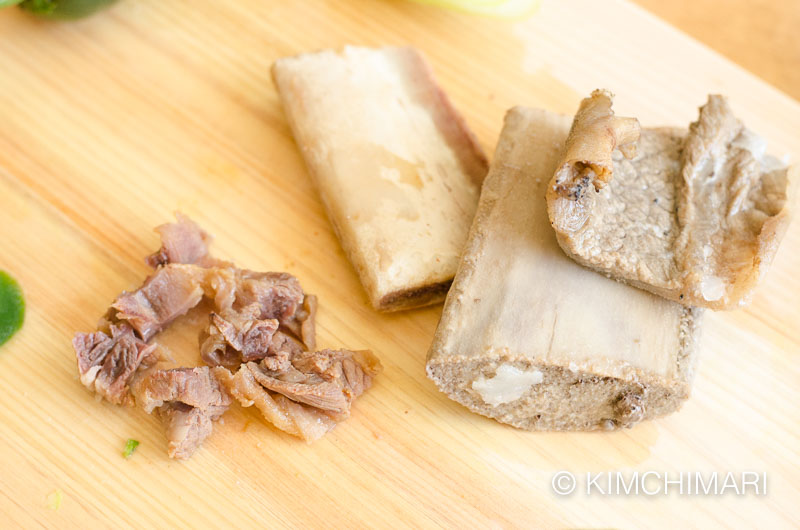
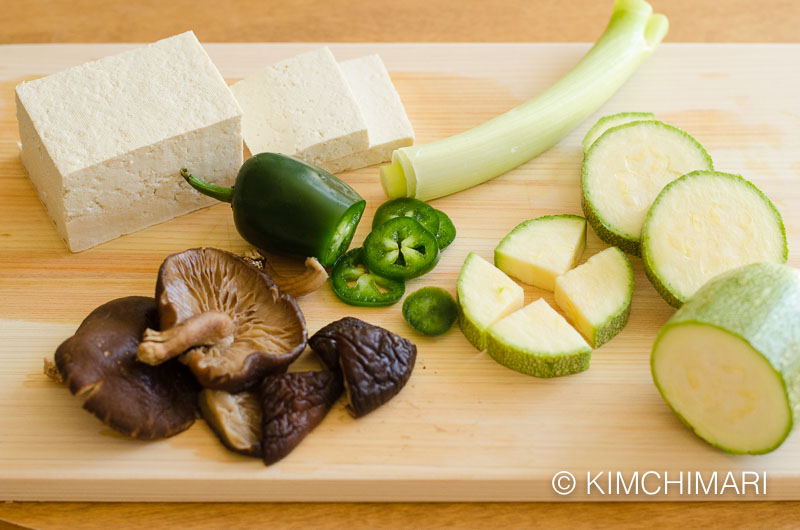
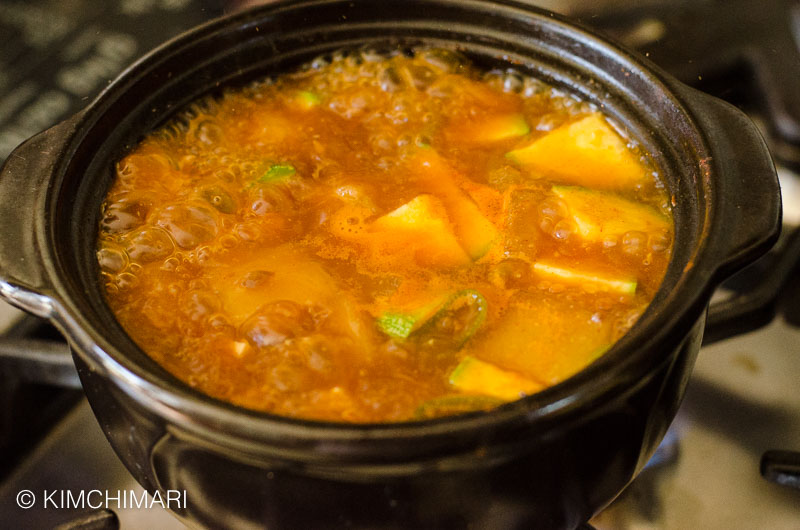
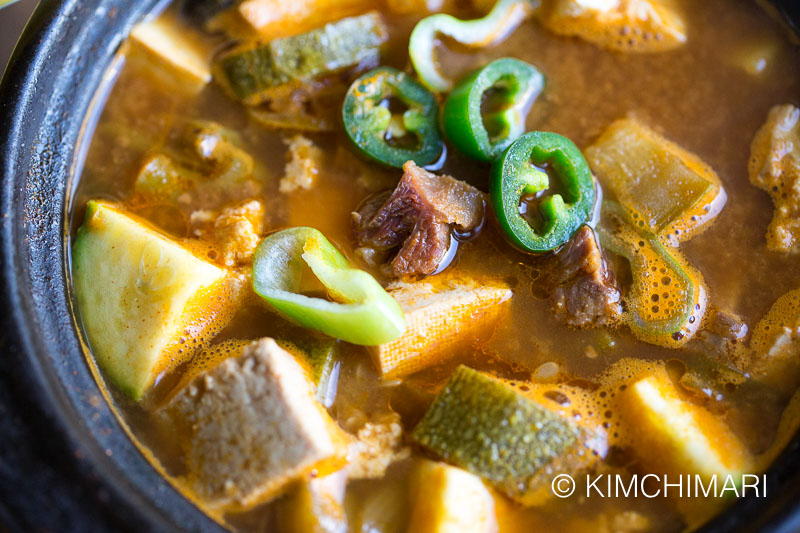
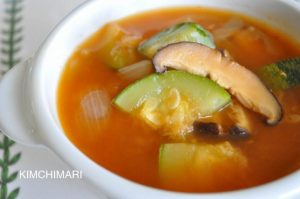

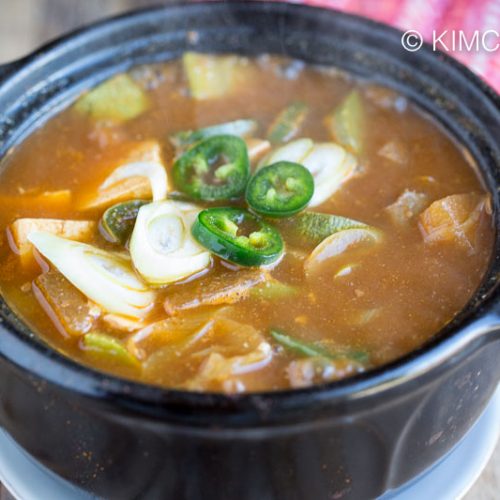

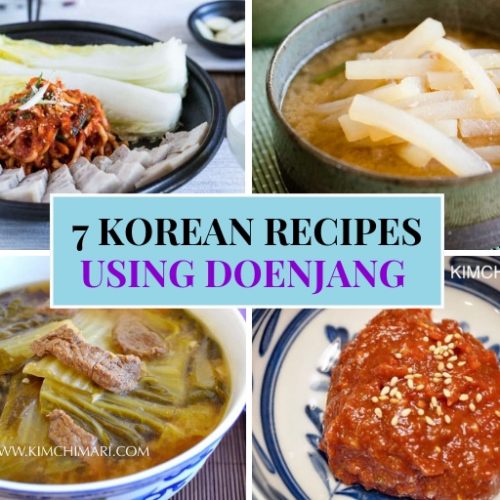
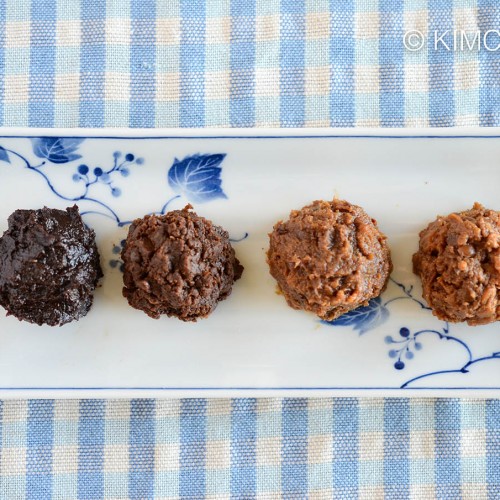
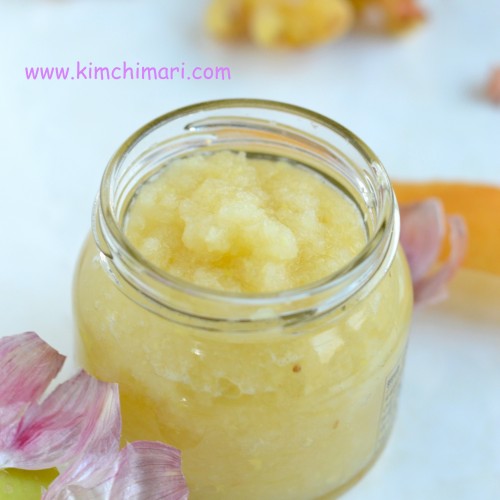
















Leave a Review